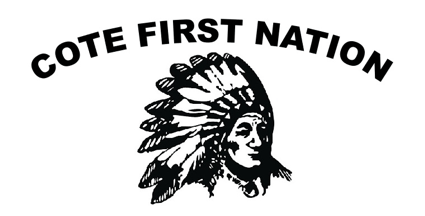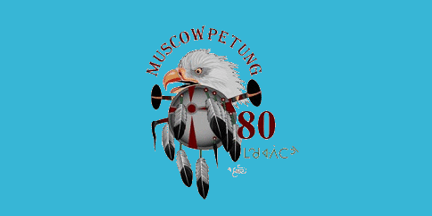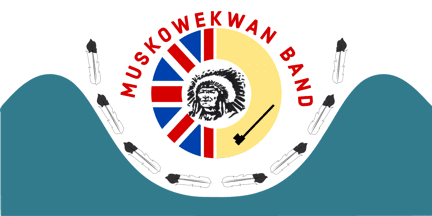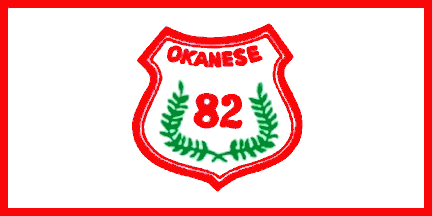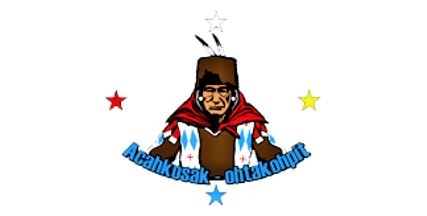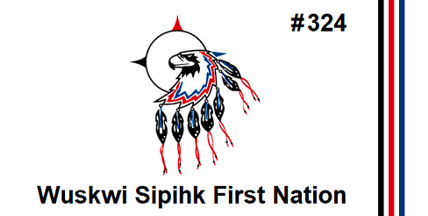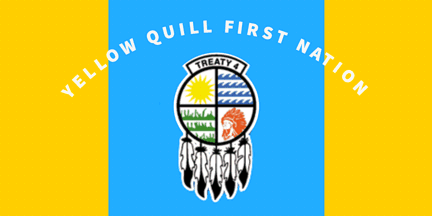Treaty Four
The flag of Treaty 4
The Treaty 4 flag stands as a powerful symbol representing the Treaty 4 agreement, signed on September 15, 1874, between the British Crown and various First Nations in what is now southern Saskatchewan, southwestern Manitoba, and southeastern Alberta. This treaty was one of the numbered treaties forged during the late 19th century, as the Canadian government sought to secure land for settlers and development while making promises to Indigenous peoples about rights and resources. The Treaty 4 flag encapsulates the spirit of that agreement, serving as a reminder of the historical, cultural, and ongoing significance of the treaty relationship.
The image shows the Treaty 4 flag, which has an oval design representing unity and inclusion. The central imagery includes a prominent yellow sunrise at the top, symbolizing new beginnings, hope, and renewal. Beneath the sunrise, a landscape is depicted, featuring a blue sky and a river cutting through green hills. The water and land emphasize the connection to nature and the importance of the environment in Treaty 4 territory.
To the right of the flag, a buffalo is shown in brown, symbolizing the traditional livelihood of the Indigenous peoples of the region and the significance of the buffalo in their culture. The years "1874" appear on both the left and right sides of the oval, marking the year Treaty 4 was signed. The text “Treaty 4” is also prominently displayed at the top left and right of the flag, framing the design.
The signing of Treaty 4 marked a pivotal moment in Canadian history, as it was part of the government's efforts to formalize agreements with Indigenous nations to facilitate westward expansion. In exchange for vast tracts of land, Indigenous leaders were promised annual payments, education, healthcare, and the protection of their traditional hunting and fishing rights. However, the promises made during the treaty negotiations were frequently broken or misinterpreted, leading to significant hardships for Indigenous communities. The Treaty 4 flag serves as a reminder of both the promises and the struggles tied to this historical agreement. It is a symbol of the resilience of the Indigenous nations who continue to fight for their rights and recognition under the treaty.
Map of the Numbered Treaties
Today, the Treaty 4 flag is proudly displayed at gatherings, ceremonies, and educational events within Treaty 4 territory. It has become a rallying symbol for Indigenous sovereignty, cultural revitalization, and treaty awareness. Schools, community centers, and public spaces in Treaty 4 territory increasingly fly the flag as a sign of respect and acknowledgment of the land’s original inhabitants and the treaty relationship.
The flag also serves as an educational tool, sparking conversations about the history of Treaty 4, the challenges of reconciliation, and the shared responsibility to honor treaty commitments. It underscores the ongoing need for dialogue, understanding, and action to address the enduring impacts of colonization. In essence, the Treaty 4 flag is far more than a piece of fabric—it is a living symbol of a shared history, a reminder of past injustices, and a beacon of hope for a future rooted in respect and collaboration.
Treaty Four Communities
Communites without Flags
Minegoziibe Anishinabe
Nekaneet
Pheasant Rump Nakota
The Key First Nation
Recently Posted
Categories
- Alberta 11
- Armed Forces 16
- British Columbia 6
- Canada 130
- Cities 64
- County / Municipality / Regional District / Township 1
- Government 9
- Historical 2
- Indigenous 17
- International Flags 26
- International Organizations 3
- Manitoba 4
- New Brunswick 3
- Newfoundland 7
- Northwest Territories 4
- Nova Scotia 6
- Nunavut 5
- Ontario 8
- Police 1
- Prince Edward Island 4
- Quebec 20
- Royalty 6
- Saskatchewan 7
- Schools 1
- Sports 4
- Yukon 2

